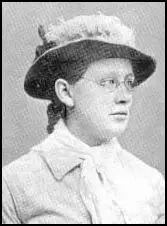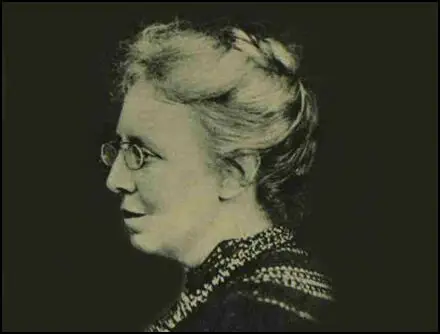Clementina Black

Clementina Black, the daughter of David Black, a solicitor and Maria Patten, a successful portrait painter, was born in Brighton on 27th July 1854. David Black was Brighton's Town Clerk but when Clementina was a child he became very ill and lost the use of both his legs. Educated at home, mainly by her mother, she became fluent in French and German.
In 1875 Clementina's mother died from a rupture caused by lifting her invalid husband. Clementina, the eldest daughter, was left in charge of an invalid father and seven brothers and sisters. In her spare time Clementina began writing fiction and in 1877, her first novel, A Sussex Idyll was published. After the death of her father she moved to London where she continued her career as a writer.
In 1886 Clementina became friends with Eleanor Marx, the daughter of the political philosopher, Karl Marx. As a result of their friendship Clementina became a member of the Women's Trade Union Association (WTUA). In 1886 Clementina Black was appointed honorary secretary of the organisation. For the next few years she travelled the country making speeches trying to persuade women to join trade unions. In 1888 she attended the Trade Union Congress where she moved a motion on equal pay for equal work.
Clementina Black was also involved in the formation of the Consumers' League, an organisation that tried to cajole customers to put pressure on employers who paid very low wages to women. One successful campaign involved the boycott of Bryant & May matches. This eventually led to the match-girl strike led by Annie Besant in 1888.
In 1889 Clementina Black helped form the Women's Trade Union Association (WTUA). Five years later this organisation joined forces with the Women's Industrial Council. Clementina became president of the council and for the next twenty years she was involved in collecting and publicizing information on women's work.
Her biographer, Janet E. Grenier, has pointed out: "The failure of the WTUA in 1894 led to the formation of the Women's Industrial Council (WIC), a new kind of organization which sent out its mainly middle-class women investigators to see for themselves conditions of working women, after which they wrote reports in an attempt to influence public opinion and government policy. Clementina Black became editor of its journal, the Women's Industrial News, in 1895 and later president of the WIC. She became increasingly active as a speaker and writer on problems facing women workers. She saw low pay as the root of the problem, and from 1896 began to campaign for a legal minimum wage. She was concerned with the plight of women home workers (usually widows or wives of casual labourers), especially in the tailoring trade in east and south London."
Black's solution to the problem of low pay was the establishment of wages boards that would enforce a minimum wage for certain types of unskilled workers. She wrote several books on the subject including Sweated Industry and the Minimum Wage (1907) and A Case for Trade Boards (1909).

Clementina Black was an active member of the Fabian Society. In 1906 Clementina Black was appointed as honorary secretary to the Women's Franchise Declaration Committee and was responsible for organising the petition demanding the vote that was signed by 257,000 women. In 1911 she became vice-president of the National Union of Suffrage Societies. She also held a similar role in London Society for Women's Suffrage. From 1912 to 1913 she was acting editor of The Common Cause. Janet E. Grenier has argued: "She realized that, without the vote, women had no power to legislate against poor working and social conditions. She became one of the vice-presidents of the London Society for Women's Suffrage in 1913."
By 1914 the Women's Industrial Council had investigated one hundred and seventeen trades. In 1915 Black and her fellow investigators published their book Married Women's Work. Black was also a member of the executive committee of the Anti-Sweating League and in the years preceding the start of the First World War she was involved with people such as Cicely Corbett Fisher and Hilda Martindale in organizing conferences on the subject. The organisation defined sweated labour as "(1) working long hours, (2) for low wages, (3) under insanitary conditions".
Despite her involvement in political issues, Clementina still found time to write novels until her failing eyesight made it impossible. One of the most successful of her books was The Agitator, a novel based on her experiences as a trade union leader.
Clementina Black died at her home in Brighton on 19 December 1922.
Primary Sources
(1) On 22nd October 1907, Clementina Black spoke at the National Union Women Workers Conference about unskilled workers.
Trade unionism could not do for the unskilled trades and the sweated industries what it could do for other trades, and they must look to the law for protection. Surely the time was coming when the law, which was the representative of the organised will of the people, would declare that British workers should no longer work for less than they could live upon.
(2) In 1909 Clementina Black's report Married Women's Work was published. Part of the report dealt with women who worked at home.
A very large majority of the women visited in their homes are kindly, industrious, reasonable, self-respecting persons and good citizens. The husbands in the main deserve the same praise… Parental affection seems to be the ruling passion of nearly all these fathers and mothers; they work hard with amazing patience in the hope of making their children happy… What is wrong is not the work for wages of married women, but the underpayment.
(3) In 1919 Clementina Black wrote a pamphlet called Hopes of Better Housing. She included one section on housing and courtship.
Young people must and will hold, somewhere, those endless talks which pave the way to marriage, and there can be no better place than their own homes; but a living room full of younger brothers and sisters and their contemporary friends will not serve the purpose at all. Young people need a parlour as a place for courting… Failing a parlour, lovers have to resort to a cinema where the eternal conversation is carried on uncomfortably in a whisper.
(4) In 1890 Clementina Black wrote a pamphlet On Marriage where she explained why some women were unwilling to get married.
Marriage, like all other human institutions, is not permanent and alterable in form, but necessarily changes shape with the changes of social development. The forms of marriage are transitional, like the societies in which they exist. Each age keeps getting ahead of the law, yet there are always some laggards of whom the law for the time being is ahead. The main tendency of our own age is towards greater freedom and equality, and the law is slowly modifying to match…. At present the strict letter of the law denies to a married woman the freedom of action which more and more women are coming to regard not only as their just but also as their dearest treasure; and this naturally causes a certain unwillingness on the part of the thoughtful women to marry… That law and custom should alike enlarge so as to suit the growing ideal is evidently desirable… we can all of us influence custom a little, since custom, after all, is only made up of many individual examples… Easier divorce may be necessary, but the opportunity of making wiser and happier marriages is more necessary still.

